

For you readers that come to this article for the first time, and have never laid eyes on this picture, excuse me just a moment the correct guess was . . . . Sally Nye!
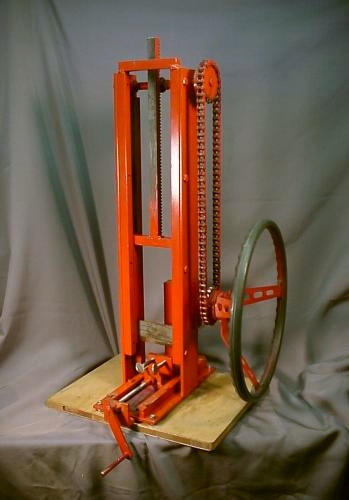

There, now that we've got that out of the way the suspense should be over, the e-mail list members don't have to read the rest of my drivel unless they want to, and I can go to the Northeast Woodcarvers' Roundup and not have to sleep with one eye open. If you just came into this, I published pictures of this machine to the Woodcarving e-mail List as a Whatzit, but they have had to wait until this article to find out who guessed what its function was. Some list members were a little more, ummmm . . . . patient(?) than others. If you are up for the long version of this story, read on!
The sole purpose of this gizmo is to cut bird feathers. In fact, it will cut feathers on two birds at the same time. For you skeptics out there, visual evidence and witness accounts will be presented later in this article. The story that comes with this beast goes back to last summer when I was lucky enough to teach at the first annual Northeast Woodcarvers' Roundup in Honesdale, Pa. Not long into the morning session of teaching my first class I started seeing these small bird carvings go flying by my table. They were these neat fan birds carved from wood. I had seen them in books as whittlin' projects before, but never tried one myself or seen one in-the-flesh. The thing that really caught my attention though was that three of these creations had been carved by non-carver spouses of woodcarvers, and two of these non-carving spouses I had never seen with carving knives in their hands before. As an aside here, we define "non-carving spouses" as a sub-category of woodcarvers, like "wood spirit carvers" or "bird carvers", only more universally loved, very essential, and usually under appreciated. So it was obvious that whoever was teaching these fan birds was running a beginner's workshop of epic proportions. I had a break on the second day of the roundup and followed the migration path of these carvings back to where they were being hatched under the guidance of Sally and David Nye. What a wonderful husband-wife team these two are, and doesn't there seem to be a lot of those teams in the world of woodcarving? Not only did I have a great time carving a fan bird, but learned about the Nye's research into the Russian origins of these carvings and how they spread across Europe, Scandinavia and then across to America. I also discovered that they had a book project in the works.
Without giving away
the how-to part of the Nyes' book, these birds are carved from
a single piece of green/wet wood. The feathers are formed by splitting
very thin layers off one end of the wood with a knife or spoke
shave. The feathers are split along the grain down to this notch
carved in the body, but not removed. These "feathers"
are then bent out at the notch and interlocked in a fan-like manner
forming the tail and wings.
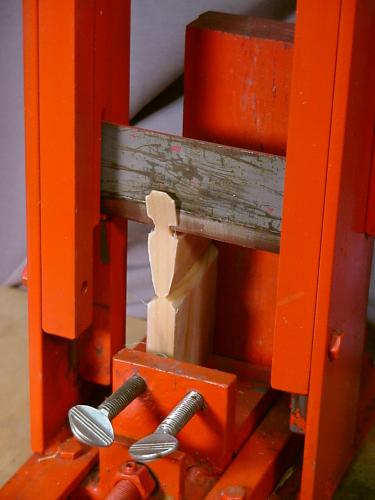 So now we fast-forward
from July to the next meeting of the Mohawk Valley Art and
Woodcarving Assoc. where those of us who attended are describing
to the rest of the membership the excellent time we had at the
Roundup, the sites we saw, and some of the things we did,
which, of course, includes the fan birds. At the meeting break,
Marcus Kruger, one of our core members, comes up to tell me about
his friend Steve who carves these birds, and even has this machine
that cuts the feathers. Marcus is a wonderful source of stories,
carvings, club history, and enthusiasm, but I confess here that
I was only mildly interested in "the machine". Once
or twice at later meetings the topic came up again and I would
listen, and nod, and say that it would be nice to see what this
thing looked like. Then, at our March meeting, Marcus comes to
me and says that Steve isn't with him tonight, but "the machine"
is. He also adds that Steve would like to trade it for one of
my Native American flutes as a gift for his daughter. Now I have
been known to use power tools occasionally, but I felt that hand
tools, and specifically the spoke shave were more appropriate
to the spirit and legend of the fan birds. Besides, I realized
that after buying the Sally and David Nye inspired Flexcut spoke
shave last fall, I seemed to be at a point where there were no
longer any tools I had to have, only tools that it would
be nice to have. So, there was this polite speech all prepared
in the back of my mind telling Marcus that it was a very nice
little machine, but I actually didn't need it. I know this lack
of tool lust is a blasphemous state for true woodcarvers, but
when Marcus lifted the back hatch on his minivan and I laid eyes
on the feather cutting behemoth he had there, I was cured! I just
had to have it! Only one flute? It's a deal!
So now we fast-forward
from July to the next meeting of the Mohawk Valley Art and
Woodcarving Assoc. where those of us who attended are describing
to the rest of the membership the excellent time we had at the
Roundup, the sites we saw, and some of the things we did,
which, of course, includes the fan birds. At the meeting break,
Marcus Kruger, one of our core members, comes up to tell me about
his friend Steve who carves these birds, and even has this machine
that cuts the feathers. Marcus is a wonderful source of stories,
carvings, club history, and enthusiasm, but I confess here that
I was only mildly interested in "the machine". Once
or twice at later meetings the topic came up again and I would
listen, and nod, and say that it would be nice to see what this
thing looked like. Then, at our March meeting, Marcus comes to
me and says that Steve isn't with him tonight, but "the machine"
is. He also adds that Steve would like to trade it for one of
my Native American flutes as a gift for his daughter. Now I have
been known to use power tools occasionally, but I felt that hand
tools, and specifically the spoke shave were more appropriate
to the spirit and legend of the fan birds. Besides, I realized
that after buying the Sally and David Nye inspired Flexcut spoke
shave last fall, I seemed to be at a point where there were no
longer any tools I had to have, only tools that it would
be nice to have. So, there was this polite speech all prepared
in the back of my mind telling Marcus that it was a very nice
little machine, but I actually didn't need it. I know this lack
of tool lust is a blasphemous state for true woodcarvers, but
when Marcus lifted the back hatch on his minivan and I laid eyes
on the feather cutting behemoth he had there, I was cured! I just
had to have it! Only one flute? It's a deal!
How does it work?
Glad you asked. It is a lot like a log splitter. With the grain
pointed upwards, the bird blank is clamped into a sliding jig
under the splitter blade. Through sprockets and a motorcycle chain,
the steering wheel cranks a splitter up and down using a rack
and pinion drive. After each slice the smaller crank in the front
moves the blank forward and perpendicular to the blade 1/32"
for every full turn of the crank.
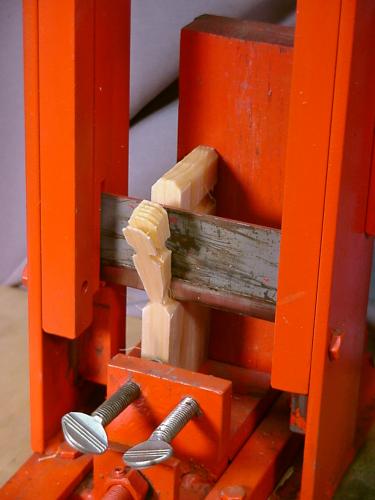
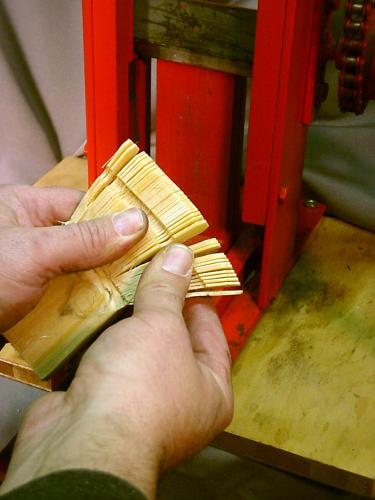
Do this 20-30 times
and pretty soon your ready to weave the feathers into a tail and
wings. And, technically, it's not a power tool. Well, unless we
take my friend's suggestion and upgrade it with an 8 horse Briggs-N-Stratton
and hydraulics. He also suggested alloy sprockets, drilled to
lessen the weight, a leather cover for the steering wheel Oh,
and pin striping. Looking back on that fateful night, I think
the "closer" on the deal was the Allis Chalmers Orange
paint job. Also there was the added, twisted appeal of a 3' tall,
50 lb. gizmo that really cannot be used for any other woodcarving
function. Just what a guy with a compact shop needs! Yeah, OK,
it could be a wood splitter for Hobbits. Even before I posted
it as a whatzit alternate uses were explored. Within a few seconds
of me placing it on the kitchen table, Yvonne suggested it could
double as a device for DIY home neutering. I informed her I had
already ruled that out. Even if "someone" were sleeping
and even if "someone" somehow deserved it, they would
hear her dragging it up from the basement in plenty of time to
escape.
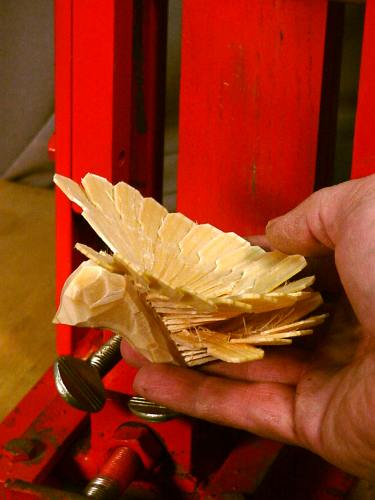 Another
motive for taking this monster shop
candidate home was, "Wait until Sally and David get a load
of this!" Which brings us to the real motive for posting
it on the Woodcarvers' E-list; I have no patience and just
could not wait until this year's Roundup to show it off.
Another
motive for taking this monster shop
candidate home was, "Wait until Sally and David get a load
of this!" Which brings us to the real motive for posting
it on the Woodcarvers' E-list; I have no patience and just
could not wait until this year's Roundup to show it off.
So Sally, it wasn't "channel vision". The contest was fixed and you had the edge from the beginning. I had no idea when I put the pictures out there the List would have as much fun as they did, but it's been a hoot. Some of the "honorable mentions"; My favorite was Sandie's "a guillotine for wooden puppets"; the one that made me laugh the loudest was Larry Robertson's "Someone ran off with the rest of your tractor!", I immediately identified with "I have no clue Mike- but I am pretty sure I need one!" also by Larry Robertson, and finally the "OH NO! Wrong answer but thanks for playing!" award goes to Alex Bisso whose keen, engineering analysis brought him so close to the answer that I was wincing when I read it.
Relax everyone; I doubt I'll ever pull out another whatzit like this one. So, until Matt gets forced into a bad decision for another article, keep them edges keen, the chips piled high, and remember the Woodcarvers' Golden Rule "You can NEVER have enough tools".
Look for Mike's review of Sally and David Nye's
book Fan Carving in this issue of WOM
Mike Bloomquist is a carver and carving teacher, and a frequent contributor to WOM.
You may visit Mike's web site, Wooden
Dreams Woodcarving HERE
or email him at m.bloomquistATverizonDOTnet.